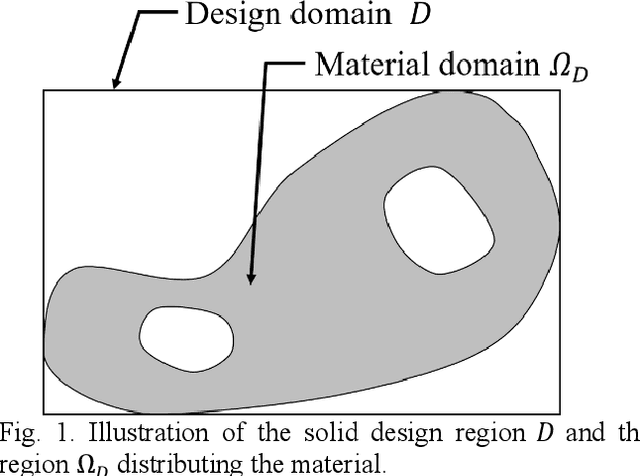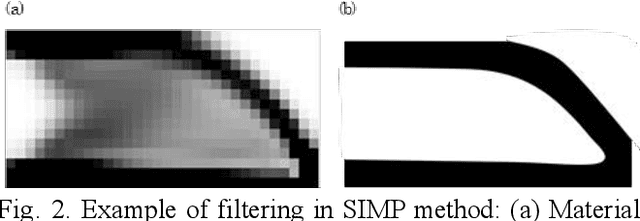Yoshiro Suzuki
Deep learning-based topological optimization for representing a user-specified design area
Apr 19, 2020



Abstract:Presently, topology optimization requires multiple iterations to create an optimized structure for given conditions. Among the conditions for topology optimization,the design area is one of the most important for structural design. In this study, we propose a new deep learning model to generate an optimized structure for a given design domain and other boundary conditions without iteration. For this purpose, we used open-source topology optimization MATLAB code to generate a pair of optimized structures under various design conditions. The resolution of the optimized structure is 32 * 32 pixels, and the design conditions are design area, volume fraction, distribution of external forces, and load value. Our deep learning model is primarily composed of a convolutional neural network (CNN)-based encoder and decoder, trained with datasets generated with MATLAB code. In the encoder, we use batch normalization (BN) to increase the stability of the CNN model. In the decoder, we use SPADE (spatially adaptive denormalization) to reinforce the design area information. Comparing the performance of our proposed model with a CNN model that does not use BN and SPADE, values for mean absolute error (MAE), mean compliance error, and volume error with the optimized topology structure generated in MAT-LAB code were smaller, and the proposed model was able to represent the design area more precisely. The proposed method generates near-optimal structures reflecting the design area in less computational time, compared with the open-source topology optimization MATLAB code.
Deep learning achieves perfect anomaly detection on 108,308 retinal images including unlearned diseases
Jan 17, 2020



Abstract:Optical coherence tomography (OCT) scanning is useful in detecting various retinal diseases. However, there are not enough ophthalmologists who can diagnose retinal OCT images in much of the world. To provide OCT screening inexpensively and extensively, an automated diagnosis system is indispensable. Although many machine learning techniques have been presented for assisting ophthalmologists in diagnosing retinal OCT images, there is no technique that can diagnose independently without relying on an ophthalmologist, i.e., there is no technique that does not overlook any anomaly, including unlearned diseases. As long as there is a risk of overlooking a disease with a technique, ophthalmologists must double-check even those images that the technique classifies as normal. Here, we show that our deep-learning-based binary classifier (normal or abnormal) achieved a perfect classification on 108,308 two-dimensional retinal OCT images, i.e., true positive rate = 1.000000 and true negative rate = 1.000000; hence, the area under the ROC curve = 1.0000000. Although the test set included three types of diseases, two of these were not used for training. However, all test images were correctly classified. Furthermore, we demonstrated that our scheme was able to cope with differences in patient race. No conventional approach has achieved the above performances. Our work has a sufficient possibility of raising automated diagnosis techniques for retinal OCT images from "assistant for ophthalmologists" to "independent diagnosis system without ophthalmologists".
Convolutional Neural Network-based Topology Optimization (CNN-TO) By Estimating Sensitivity of Compliance from Material Distribution
Dec 23, 2019



Abstract:This paper proposes a new topology optimization method that applies a convolutional neural network (CNN), which is one deep learning technique for topology optimization problems. Using this method, we acquire a structure with a little higher performance that could not be obtained by the previous topology optimization method. In particular, in this paper, we solve a topology optimization problem aimed at maximizing stiffness with a mass constraint, which is a common type of topology optimization. In this paper, we first formulate the conventional topology optimization by the solid isotropic material with penalization method. Next, we formulate the topology optimization using CNN. Finally, we show the effectiveness of the proposed topology optimization method by solving a verification example, namely a topology optimization problem aimed at maximizing stiffness. In this research, as a result of solving the verification example for a small design area of 16x32 element, we obtain the solution different from the previous topology optimization method. This result suggests that stiffness information of structure can be extracted and analyzed for structural design by analyzing the density distribution using CNN like an image. This suggests that CNN technology can be utilized in the structural design and topology optimization.
 Add to Chrome
Add to Chrome Add to Firefox
Add to Firefox Add to Edge
Add to Edge